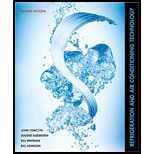
Concept explainers
The low-pressure side of the system must not be pressurized to more than
A. 75 psig.
B. 200 psig.
C. the low-side design pressure.
D. atmospheric pressure.
The maximum pressure up to which the low pressure side of the system can be pressurized.
Answer to Problem 1RQ
The maximum pressure up to which the low pressure side of the system can be pressurized
Explanation of Solution
The pressure used to pressurize a system must not exceed the lowest pressure for the system. The system which is being subjected to pressurization must be allowed to stand still for a time period of at least 10 minutes. This will allow for the equalization of the pressure in the system. After the equalization of the pressure, it is important to mark the high pressure gauge after tapping the gauge to settle down the needle.
The low pressure side of the refrigeration system has a normal working pressure of
The low pressure side of the refrigeration system includes evaporator, compressor and the suction line. The compressor head and the outlet or the discharge head are taken to be on the high pressure side of the system. The test pressure in the high pressure side of the refrigeration system for a majority of the refrigerants is minimum
Conclusion:
The maximum pressure up to which the low pressure side of the system can be pressurized
Want to see more full solutions like this?
Chapter 8 Solutions
Bundle: Refrigeration and Air Conditioning Technology, 8th + MindTap HVAC, 4 terms (24 months) Printed Access Card
- Correct answer is written below. Detailed and complete solution with fbd only. I will upvote, thank you.arrow_forwardCorrect answer is written below. Detailed and complete solution only with fbd. I will upvote, thank you.arrow_forwardCorrect answer is written below. Detailed and complete solution only. I will upvote, thank you.arrow_forward
- Correct answer is written below. Detailed and complete solution with fbd only. I will upvote, thank you.arrow_forwardCorrect answer is written below. Detailed and complete solution only. I will upvote, thank you.arrow_forwardCorrect answer is written below. Detailed and complete solution with fbd only. I will upvote, thank you.arrow_forward
- Correct answer is written below. Detailed and complete solution only. I will upvote, thank you.arrow_forwardCorrect answer is written below. Detailed and complete solution only. I will upvote, thank you.arrow_forwardCorrect answer is written below. Detailed and complete solution only. I will upvote, thank you.arrow_forward
- Correct answer is written below. Detailed and complete solution with fbd only. I will upvote, thank you. Prefferably handwritten solution pleasearrow_forwardCorrect answer is written below. Detailed and complete solution with fbd only. I will upvote, thank you. Prefferably handwritten solution pleasearrow_forwardCorrect answer is written below. Detailed and complete solution only. I will upvote, thank you.arrow_forward
 Refrigeration and Air Conditioning Technology (Mi...Mechanical EngineeringISBN:9781305578296Author:John Tomczyk, Eugene Silberstein, Bill Whitman, Bill JohnsonPublisher:Cengage Learning
Refrigeration and Air Conditioning Technology (Mi...Mechanical EngineeringISBN:9781305578296Author:John Tomczyk, Eugene Silberstein, Bill Whitman, Bill JohnsonPublisher:Cengage Learning Welding: Principles and Applications (MindTap Cou...Mechanical EngineeringISBN:9781305494695Author:Larry JeffusPublisher:Cengage Learning
Welding: Principles and Applications (MindTap Cou...Mechanical EngineeringISBN:9781305494695Author:Larry JeffusPublisher:Cengage Learning Precision Machining Technology (MindTap Course Li...Mechanical EngineeringISBN:9781285444543Author:Peter J. Hoffman, Eric S. Hopewell, Brian JanesPublisher:Cengage Learning
Precision Machining Technology (MindTap Course Li...Mechanical EngineeringISBN:9781285444543Author:Peter J. Hoffman, Eric S. Hopewell, Brian JanesPublisher:Cengage Learning


